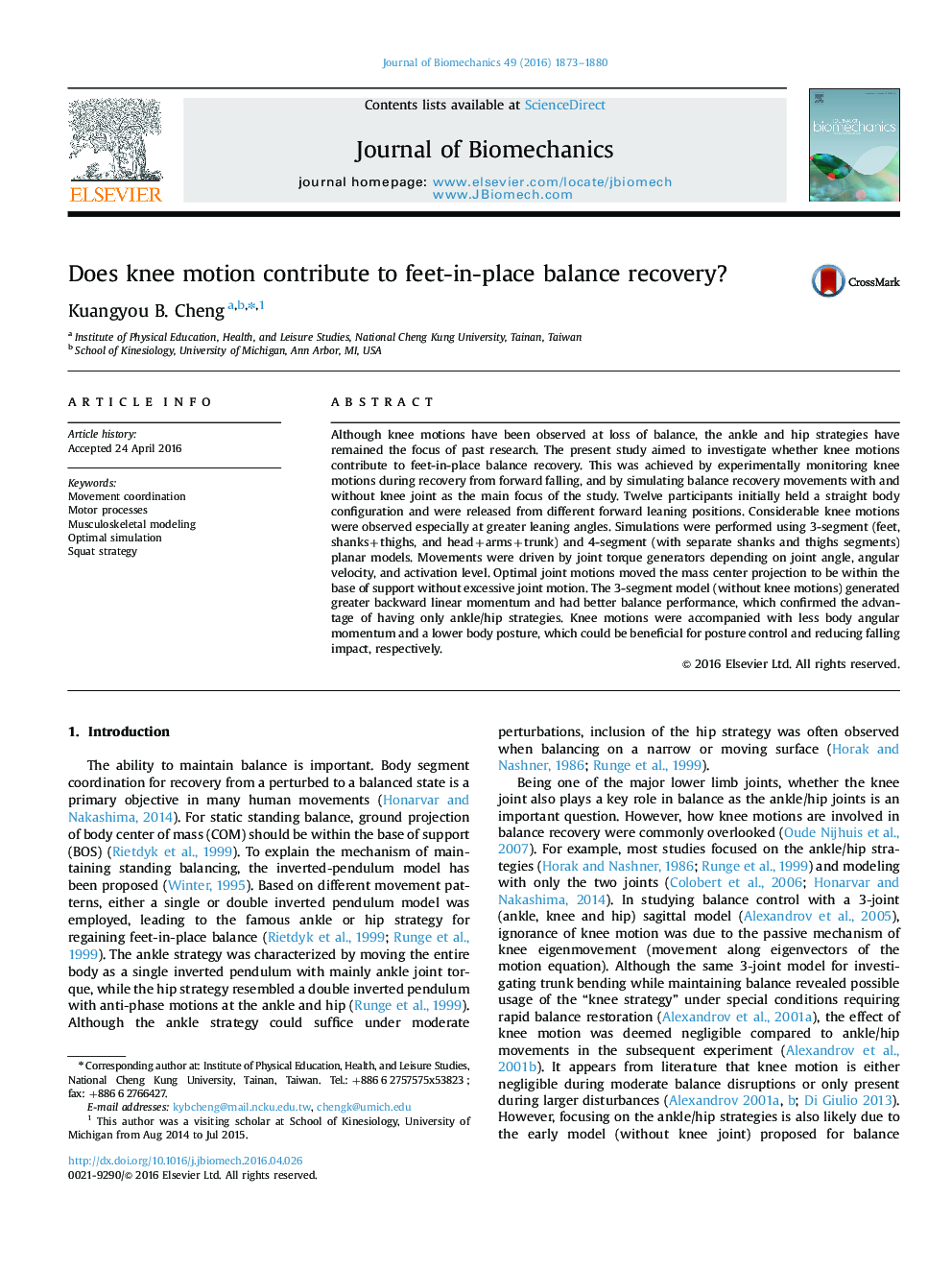| کد مقاله | کد نشریه | سال انتشار | مقاله انگلیسی | نسخه تمام متن |
|---|---|---|---|---|
| 10431088 | 910195 | 2016 | 8 صفحه PDF | دانلود رایگان |
عنوان انگلیسی مقاله ISI
Does knee motion contribute to feet-in-place balance recovery?
ترجمه فارسی عنوان
آیا حرکت زانو به بهبود تعادل پایینی کمک می کند؟
دانلود مقاله + سفارش ترجمه
دانلود مقاله ISI انگلیسی
رایگان برای ایرانیان
کلمات کلیدی
هماهنگی حرکت، فرایندهای موتور، مدلسازی اسکلتی عضلانی شبیه سازی بهینه، استراتژی اسکات،
ترجمه چکیده
اگرچه حرکات زانو در هنگام از دست دادن تعادل مشاهده شده است، اما تمرینات گذشته و تمرینات گذشته، تمرینات مچ پا و لگن باقی مانده است. هدف از این مطالعه بررسی اینکه آیا حرکات زانو به بهبود بازنشستگی پایینی کمک می کند. این امر با آزمایش تجربی حرکت های زانو در طی بهبودی از سقوط به جلو و با شبیه سازی حرکات بازیابی تعادل با و بدون مفصل زانو به عنوان تمرکز اصلی مطالعه انجام شد. دوازده شرکت کننده در ابتدا یک پیکربندی صحیح را انجام دادند و از موقعیت های متفاوتی از پیش تعیین شده خارج شدند. حرکات قابل توجهی زانو به خصوص در زاویه های بیشتر دیده می شود. شبیه سازی ها با استفاده از مدل های مسطح با استفاده از 3 قطعه (پایه، شانه + ران و سر + سلاح + تنه) و 4 قطعه (با بخش های شانک و ران جداگانه) انجام شد. جنبشها به وسیله ژنراتورهای گشتاور مشترک بسته به زاویه مشترک، سرعت زاویه ای و سطح فعالسازی رانده شدند. حرکتهای بهینه متحرک، طرح مرکز مرکزی را در داخل پایه پشتیبانی بدون حرکت مشترک بیش از حد حرکت داد. مدل سه بعدی (بدون حرکت زانو) موجب حرکت بیشتر به عقب خطی شد و دارای عملکرد بالاتری بود که از مزایای استفاده از استراتژی های مچ پا و راننده پشتیبانی می کرد. حرکات زانو با حرکت زاویهای کمتر بدن و وضعیت بدن کمتری همراه بود، که می تواند برای کنترل وضعیت و کاهش اثر سقوط، مفید باشد.
موضوعات مرتبط
مهندسی و علوم پایه
سایر رشته های مهندسی
مهندسی پزشکی
چکیده انگلیسی
Although knee motions have been observed at loss of balance, the ankle and hip strategies have remained the focus of past research. The present study aimed to investigate whether knee motions contribute to feet-in-place balance recovery. This was achieved by experimentally monitoring knee motions during recovery from forward falling, and by simulating balance recovery movements with and without knee joint as the main focus of the study. Twelve participants initially held a straight body configuration and were released from different forward leaning positions. Considerable knee motions were observed especially at greater leaning angles. Simulations were performed using 3-segment (feet, shanks+thighs, and head+arms+trunk) and 4-segment (with separate shanks and thighs segments) planar models. Movements were driven by joint torque generators depending on joint angle, angular velocity, and activation level. Optimal joint motions moved the mass center projection to be within the base of support without excessive joint motion. The 3-segment model (without knee motions) generated greater backward linear momentum and had better balance performance, which confirmed the advantage of having only ankle/hip strategies. Knee motions were accompanied with less body angular momentum and a lower body posture, which could be beneficial for posture control and reducing falling impact, respectively.
ناشر
Database: Elsevier - ScienceDirect (ساینس دایرکت)
Journal: Journal of Biomechanics - Volume 49, Issue 9, 14 June 2016, Pages 1873-1880
Journal: Journal of Biomechanics - Volume 49, Issue 9, 14 June 2016, Pages 1873-1880
نویسندگان
Kuangyou B. Cheng,
